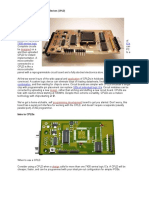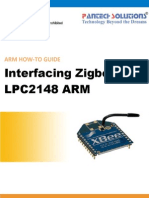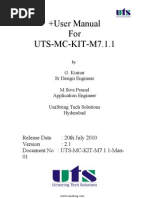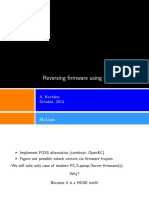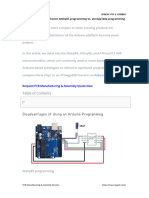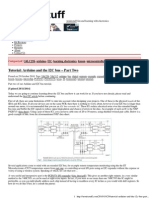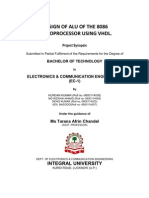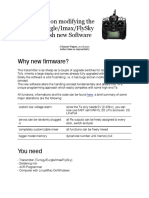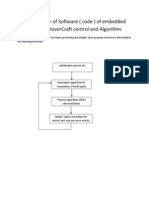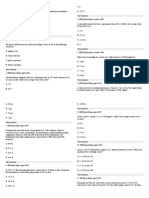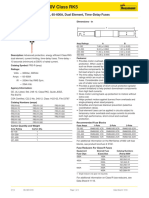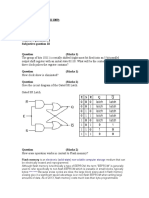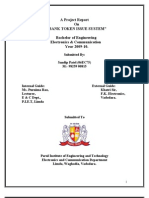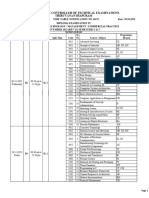Evaluation Board s08dz60
Evaluation Board s08dz60
Uploaded by
Warren O LeddaCopyright:
Available Formats
Evaluation Board s08dz60
Evaluation Board s08dz60
Uploaded by
Warren O LeddaCopyright
Available Formats
Share this document
Did you find this document useful?
Is this content inappropriate?
Copyright:
Available Formats
Evaluation Board s08dz60
Evaluation Board s08dz60
Uploaded by
Warren O LeddaCopyright:
Available Formats
Evaluation Board MCS08DZ60 LQFP32 The board shown in this article is build around a recent microcontroller from Freescale.
It has some interesting features presented below, and is initially developed to learn with the CAN bus. It is an easy to build board particularly adapted for beginners.
The microcontroller The microcontroller used is the 68HCS08DZ60, from Freescale, and coming with an LQFP32 package. It is initially a microcontroller designed for automotive applications. It has some very interesting features: - 60Ko of Flash memory; - 4Ko of RAM; - 2Ko of EEPROM ; - Integrated CAN bus controller; - Integrated SCI controller with LIN capability; - Integrated I2C controller; - Integrated SPI controller; - Analog inputs, with a resolution of 12bits; - Timers which can generated PWM signals; - And more... The board Please, see the schematic of the board. The board has been initially developed to learn with CAN, so a CAN transceiver is available (IC4). The CAN transceiver comes from Maxim, but some other manufacturers provide some compatible CAN transceivers which can be used. An RS232 transceiver is also mounted on the board to get an RS232 interface, to connect the board to a computer. It could be used for debug purpose for example. Both transceivers are connected to the microcontroller throw jumpers, so it is possible to disconnect the transceivers and use the pin of the microcontroller as classical GPIOs. The other parts of the schematic are not so special, we can found: - The power supply, build around a DC/DC converter (IC1 ; a classical linear voltage regulator like 7805 can also be used without any modification of the PCB); - A LED to indicate that the board is supplied (LED1); - A switch connected on the RESET pin of the microcontroller (S1); - The crystal (Q1). Note that the crystal is connected to the microcontroller throw jumpers: the device can work with an internal clock and in this case, the pins are available as classical GPIOs. - Finally, there are some decoupling capacitors for all integrated circuits. The power of the board will be applied on K1. Any power supplied can be used if it provided between 8 to 12 Volts AC or DC. K2 will be used to connect the programming cable, and K3 gives an access to all the pins of the microcontroller. K3 is build with two arrays of connectors to plug a module on the evaluation board (see photo #1). The eagle project (schematic and board) is attached to this document. Programming the microcontroller To program the microcontroller, you will need a programming cable for Freescale HCS08 devices and you will have to download CodeWarrior for Microcontrollers from Freescale Web Site.
Open source debugging cable and examples to begin with this board (CAN, 1-Wire, IC, EEPROM ) are shown on my Web Site: http://myfreescalewebpage.free.fr.
Conclusion This small evaluation board is easy to build and will enable lots of experimentations. I have make two boards in order to create a small network throw the CAN interface. Of course this board is also interesting if you want to develop application around IC, SPI, SCI Remember that the peripherals available on the 8bits devices from Freescale are the same than on the 16 and 32bits devices, like the Coldfire for example. It is why this board is maybe the best way to start programming and learning with Freescale devices.
You might also like
- ESP32 Development Using The Arduino IDEDocument162 pagesESP32 Development Using The Arduino IDEGOMEZ100% (4)
- Tle Project-Night SwitchDocument2 pagesTle Project-Night SwitchDan Felix100% (1)
- Devloper BoardDocument82 pagesDevloper Boardpukhraj titreNo ratings yet
- Inter-Integrated Circuit (I2C) : Karthik Hemmanur ECE 480-Design Team 3 Fall 2009Document8 pagesInter-Integrated Circuit (I2C) : Karthik Hemmanur ECE 480-Design Team 3 Fall 2009gluciferNo ratings yet
- LC MeterDocument10 pagesLC MeterYenidir TeknoNo ratings yet
- NXP CatalogDocument30 pagesNXP CatalogAnshul Srivastava100% (2)
- T89C51 Training Board - V5Document44 pagesT89C51 Training Board - V5davidegrimaNo ratings yet
- Complex Programmable Logic DevicesDocument15 pagesComplex Programmable Logic DevicesAbd AhmmadNo ratings yet
- Atmega32 Dev Board - EFY March11 PDFDocument7 pagesAtmega32 Dev Board - EFY March11 PDFsagar_gy100% (1)
- Basic PIC 40 Development BoardDocument8 pagesBasic PIC 40 Development BoardBasit Ahmad100% (3)
- I2c PaperDocument14 pagesI2c PaperParvinder Singh100% (1)
- CAN Bus Development With ESP32Document6 pagesCAN Bus Development With ESP32Martin MtawaliNo ratings yet
- Atmega32 Development BoardDocument30 pagesAtmega32 Development BoardAlishaKorNo ratings yet
- Elesof: Dc-MotorDocument44 pagesElesof: Dc-Motorabhay2703100% (3)
- Intel (Altera) Cyclone V FPGA BoardsDocument24 pagesIntel (Altera) Cyclone V FPGA BoardsjackNo ratings yet
- VHDL Tutorial-Part 1-Adc-SpiDocument7 pagesVHDL Tutorial-Part 1-Adc-Spihieuhuech1No ratings yet
- Adafruit Ccs811 Air Quality Sensor-1396546Document22 pagesAdafruit Ccs811 Air Quality Sensor-1396546Camilo PradaNo ratings yet
- Beginning FPGA Programming - Partie7Document5 pagesBeginning FPGA Programming - Partie7ali alilouNo ratings yet
- PIC LAB ManualDocument13 pagesPIC LAB ManualxyzzyzNo ratings yet
- CapstoneDocument16 pagesCapstoneHarsh ShahNo ratings yet
- HomeDocument65 pagesHomecrsarinNo ratings yet
- STMW Internet - of - Things - Lab - ManualDocument50 pagesSTMW Internet - of - Things - Lab - ManualthummalakuntasNo ratings yet
- Submitted To: Submitted By:: (Department of Electronics and Instrumentation Engg.)Document19 pagesSubmitted To: Submitted By:: (Department of Electronics and Instrumentation Engg.)nikboy88No ratings yet
- Microprocessor Interfacing TechniquesDocument351 pagesMicroprocessor Interfacing Techniquesjsa100% (3)
- Zigbee Interfacing ARM7 PrimerDocument14 pagesZigbee Interfacing ARM7 PrimervivekgwdNo ratings yet
- Assignment Set I (1) UpdateDocument15 pagesAssignment Set I (1) UpdateAshish OjhaNo ratings yet
- PIC of An IDer PDFDocument5 pagesPIC of An IDer PDFronaldbolorbaral8809100% (1)
- Programming STC MCUDocument15 pagesProgramming STC MCUsskendre100% (1)
- 3 NODEMCU 1st LectureDocument84 pages3 NODEMCU 1st LectureSukhpreet SinghNo ratings yet
- LPC2148 Quick Start Board Users Guide-Version 1.0 Rev ADocument17 pagesLPC2148 Quick Start Board Users Guide-Version 1.0 Rev ArsudjianNo ratings yet
- 18F13k50 Overview41358aDocument2 pages18F13k50 Overview41358angt881No ratings yet
- Esamcb51 UmDocument28 pagesEsamcb51 Umtallurips91No ratings yet
- PIC16F877 Microcontroller TutorialDocument37 pagesPIC16F877 Microcontroller Tutorialmc_prayer100% (4)
- 8051 LAB Manual NewDocument189 pages8051 LAB Manual New9491104570100% (2)
- h2hc2014 Reversing Firmware Radare SlidesDocument46 pagesh2hc2014 Reversing Firmware Radare SlidesntcaseNo ratings yet
- Ipc I 165 Pci Manual EnglishDocument15 pagesIpc I 165 Pci Manual EnglishCHAIRMANNo ratings yet
- Xilinx XC2C128-6VQG100C - 5G Technology - Cloud ComputingDocument4 pagesXilinx XC2C128-6VQG100C - 5G Technology - Cloud ComputingjackNo ratings yet
- PIC With LCD and ICSP Programmer Board - v3 - JRMDocument7 pagesPIC With LCD and ICSP Programmer Board - v3 - JRMm_menaka100% (2)
- Programming AVR Micro Controllers in CDocument50 pagesProgramming AVR Micro Controllers in CDhishan AmaranathNo ratings yet
- Open Source Development BoardsDocument20 pagesOpen Source Development BoardsRemyaNo ratings yet
- Ec6711 Emb Lab PDFDocument92 pagesEc6711 Emb Lab PDFAnonymous LXQnmsD100% (1)
- WinPicProg PIC TutorialDocument3 pagesWinPicProg PIC TutorialPrabodaLakruwanRupanandaNo ratings yet
- Tailieuxanh Nigel Pic Tutorial Hardware 10 5422Document13 pagesTailieuxanh Nigel Pic Tutorial Hardware 10 5422Nguyen HANo ratings yet
- Lpc2148 User ManualDocument5 pagesLpc2148 User ManualSnaidyNo ratings yet
- Rapid28i™ PIC Prototyping PCB User ManualDocument5 pagesRapid28i™ PIC Prototyping PCB User ManualPaul WrightNo ratings yet
- Micro Board Rev 5Document50 pagesMicro Board Rev 5Arman100% (1)
- Android Controlled Home AppliancesDocument60 pagesAndroid Controlled Home AppliancesWaseem AshrafNo ratings yet
- Making Laser Engraving Circuit Boards in ElectronicsDocument13 pagesMaking Laser Engraving Circuit Boards in ElectronicsjackNo ratings yet
- Tutorial - Arduino and The I2C Bus - Part TwoDocument16 pagesTutorial - Arduino and The I2C Bus - Part TwoSigid Ariewibowo100% (1)
- Dspic Control Board: For Industrial ApplicationsDocument5 pagesDspic Control Board: For Industrial Applicationstakaca40No ratings yet
- Pic ReportDocument46 pagesPic ReportknlkohliNo ratings yet
- C CCC CCC C CC C CDocument6 pagesC CCC CCC C CC C CMd Rizwan AhmadNo ratings yet
- School of Electrical Engineering: The University of Faisalabad, Faisalabad, PakistanDocument12 pagesSchool of Electrical Engineering: The University of Faisalabad, Faisalabad, PakistanSHAROON SARDAR GHULAMNo ratings yet
- lpc2148Document10 pageslpc2148HamedRazaNo ratings yet
- DatasheetDocument2 pagesDatasheetSai Krishna BangaruNo ratings yet
- Mpi Final Report V FinalDocument16 pagesMpi Final Report V FinalAsim AslamNo ratings yet
- STK500 User GuideDocument16 pagesSTK500 User GuideupeshalaNo ratings yet
- Turngy 9x ManualDocument7 pagesTurngy 9x Manualتيه تاريق مادوNo ratings yet
- PIC Programming Module USB and Traffic Light System ControllerDocument26 pagesPIC Programming Module USB and Traffic Light System ControllerJosh, LRT100% (1)
- PLC: Programmable Logic Controller – Arktika.: EXPERIMENTAL PRODUCT BASED ON CPLD.From EverandPLC: Programmable Logic Controller – Arktika.: EXPERIMENTAL PRODUCT BASED ON CPLD.No ratings yet
- Neo Geo Architecture: Architecture of Consoles: A Practical Analysis, #23From EverandNeo Geo Architecture: Architecture of Consoles: A Practical Analysis, #23No ratings yet
- RXYQ U.idownloadDocument136 pagesRXYQ U.idownloadHassan MehrizNo ratings yet
- Fpga WikipediaDocument16 pagesFpga Wikipedianirmaljohn1920No ratings yet
- Hovercraft and PlansDocument7 pagesHovercraft and PlansZeeshan AhmadNo ratings yet
- EC1258 - Digital Electronics Laboratory Manual (REC)Document94 pagesEC1258 - Digital Electronics Laboratory Manual (REC)jeyaganesh100% (8)
- AC Circuits For PracticeDocument49 pagesAC Circuits For PracticejehanNo ratings yet
- WDM Concept and Components-1Document66 pagesWDM Concept and Components-1UDDALAKNo ratings yet
- ZUCCHINI Busbar SCP Series Technical Catalog PDFDocument77 pagesZUCCHINI Busbar SCP Series Technical Catalog PDFJahnValjahnNo ratings yet
- Rexroth Pilot ValvesDocument12 pagesRexroth Pilot ValvesDavid RossNo ratings yet
- Woodward - SPC Servo Position Controller-1Document4 pagesWoodward - SPC Servo Position Controller-1Beto GomezNo ratings yet
- Rtd4Al: RTD Temperature Sensor For Temperature Measurement Up To 900°F (482°C)Document2 pagesRtd4Al: RTD Temperature Sensor For Temperature Measurement Up To 900°F (482°C)gabrielpmendesNo ratings yet
- Chapter 3Document25 pagesChapter 3Nehal HassanNo ratings yet
- Group 6 - Electrical SafetyDocument14 pagesGroup 6 - Electrical SafetyNiña Marie RoblesNo ratings yet
- 29WK500Document19 pages29WK500Claudio Teruo TanakaNo ratings yet
- Assignment 2Document3 pagesAssignment 2muhammad.shahrukhNo ratings yet
- MB945 - User Manual - V1.0BDocument77 pagesMB945 - User Manual - V1.0Bpablo salvatierraNo ratings yet
- 10_JEE Main Full Test-10_Only Sol. With QRDocument12 pages10_JEE Main Full Test-10_Only Sol. With QRyadavashwin359No ratings yet
- Coois09883 1-2539658Document4 pagesCoois09883 1-2539658Andres Alvizo HernandezNo ratings yet
- cs302 Fall 2009Document45 pagescs302 Fall 2009aamir shahzadNo ratings yet
- Bhel Haridwar Summer Training Report Electronic & CommunicationDocument22 pagesBhel Haridwar Summer Training Report Electronic & Communicationritika_arora19067% (3)
- Sim Xxi Electrical / Wiring Diagram Verification ChecklistDocument1 pageSim Xxi Electrical / Wiring Diagram Verification ChecklistSaravana KumarNo ratings yet
- Tdoct6548 EngDocument104 pagesTdoct6548 EngYesid EstepaNo ratings yet
- Test Report For Feeder Protection RELAY (P111) : Sheet: 1 Of: 6Document6 pagesTest Report For Feeder Protection RELAY (P111) : Sheet: 1 Of: 6Subramaniam NPNo ratings yet
- Basics of Semiconductor DevicesDocument31 pagesBasics of Semiconductor DevicesN 236No ratings yet
- Capxon (Radial) 2011 FH SeriesDocument4 pagesCapxon (Radial) 2011 FH Serieshes545No ratings yet
- Fractional Time Delay Estimation AlgorithmDocument8 pagesFractional Time Delay Estimation AlgorithmandradesosNo ratings yet
- Bank Token Display Systemm Usin Micro Controller)Document73 pagesBank Token Display Systemm Usin Micro Controller)sandy_18_sn587971% (7)
- Nanoscale: Broadband Mid-Infrared Metalens With Polarization-Controlled At-Will Chromatic DispersionDocument7 pagesNanoscale: Broadband Mid-Infrared Metalens With Polarization-Controlled At-Will Chromatic DispersionResalatFaruqueNuhNo ratings yet
- Final - Time Table 2023 - Nov - Rev21Document6 pagesFinal - Time Table 2023 - Nov - Rev21abhinavghosh159No ratings yet
- P142 OrderForm - v46 - 032021 - MBADocument11 pagesP142 OrderForm - v46 - 032021 - MBATuan Dang AnhNo ratings yet







